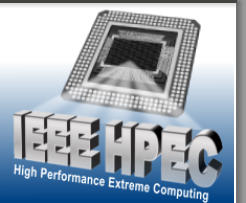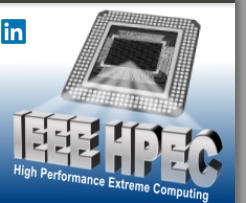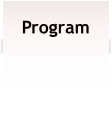
2018 IEEE High Performance
Extreme Computing Conference
(HPEC ‘18)
Twenty-second Annual HPEC Conference
25 - 27 September 2018
Westin Hotel, Waltham, MA USA


Hyperscaling Internet Graph Analysis with D4M on the MIT SuperCloud
Detecting anomalous behavior in network traffic is a major challenge due to the volume and velocity of network traffic. For
example, a 10 Gigabit Ethernet connection can generate over 50 MB/s of packet headers. For global network providers, this
challenge can be amplified by many orders of magnitude. Development of novel computer network traffic analytics requires: high
level programming environments, massive amount of packet capture (PCAP) data, and diverse data products for “at scale”
algorithm pipeline development. D4M (Dynamic Distributed Dimensional Data Model) combines the power of sparse linear
algebra, associative arrays, parallel processing, and distributed databases (such as SciDB and Apache Accumulo) to provide a
scalable data and computation system that addresses the big data problems associated with network analytics development.
Combining D4M with the MIT SuperCloud manycore processors and parallel storage system enables network analysts to
interactively process massive amounts of data in minutes. To demonstrate these capabilities, we have implemented a
representative analytics pipeline in D4M and benchmarked it on 96 hours of Gigabit PCAP data with MIT SuperCloud. The entire
pipeline from uncompressing the raw files to database ingest was implemented in 135 lines of D4M code and achieved speedups
of over 20,000.
Performance of Graph Analytics Applications on Many-Core Processors
Attaining good performance on graph analytics applications on modern day many-core processors is challenging, because these
processors have complex pipelines to manage out of order execution of hundreds of instructions in flight. These pipelines have
been optimized for high performance computing (HPC) applications, not for graph analytics. It is preferable to leave the task of
attaining good performance to the system developers, and to separate the performance concern from the application
programmer's concerns. In this paper, we show that the linear algebra formulation of graph-analytics effectively handles the
aforementioned separation of concerns. This formulation is a better fit for many-core processors as the many-core processors
are optimized for HPC applications which have a substantial linear algebra component. We show that on POWER8, a many-
core processor, an eight-fold performance advantage can be attained on the Graph500 benchmark by adopting the linear algebra
formulation. We also present the CPI stack analysis of three graph analytics kernels, and show that the linear algebra
implementations of these kernels make efficient use of the POWER8 core. Inhibitors to still better performance are discussed.
Towards Triangle Counting on GPU using Stable Radix binning
The pattern of computations of graph algorithms makes them difficult to parallelize. They suffer from erratic data access patterns.
We propose a set of algorithmic patterns that enable users to take advantage of fine grained parallelism provided by modern
CPU and GPU architectures. This allows accesses to be regularized which improves hierarchical cache access. We also
propose a parallel stable binning algorithm that can be used for computing set intersection. This is illustrated through its
application to triangle counting in large graphs.
Chapel HyperGraph Library (CHGL)
We present the Chapel Hpergraph Library (CHGL), a library for hypergraph computation in the emerging Chapel language.
Hypergraphs generalize graphs, where a hypergraph edge can connect any number of vertices. Thus, hypergraphs capture high-
order, high-dimensional interactions between multiple entities that are not directly expressible in graphs. CHGL is designed to
provide HPC-class computation with high-level abstractions and modern language support for parallel computing on shared
memory and distributed memory systems. In this paper we describe the design of CHGL, including first principles, data
structures, and algorithms, and we present preliminary performance results based on a graph generation use case. We also
discuss ongoing work of codesign with Chapel, which is currently centered on improving performance.
Performance Effects of Dynamic Graph Data Structures in Community Detection Algorithms
Community detection algorithms create a dynamic graph as an internal data structure for tracking agglomerative merges. This
community (block) graph is modified heavily through operations derived from moving vertices between candidate communities.
We study the problem of choosing the optimal graph representation for this data structure and analyze the performance
implications theoretically and empirically. These costs are analyzed in the context of Peixoto’s Markov Chain Monte Carlo
algorithm for stochastic block model inference, but apply to agglomerative hierarchical community detection algorithms more
broadly. This cost model allows for evaluating data structures for implementing this algorithms and we identify inherent properties
of the algorithm that exclude certain optimizations.
Wednesday September 26, 2018
Graphs & Sparse Data 2
1:00-2:40 in Eden Vale A3
Chair: Scott McMillan / CMU



Hyperscaling Internet Graph Analysis with D4M on the MIT
SuperCloud
Detecting anomalous behavior in network traffic is a major
challenge due to the volume and velocity of network traffic. For
example, a 10 Gigabit Ethernet connection can generate over 50
MB/s of packet headers. For global network providers, this
challenge can be amplified by many orders of magnitude.
Development of novel computer network traffic analytics requires:
high level programming environments, massive amount of packet
capture (PCAP) data, and diverse data products for “at scale”
algorithm pipeline development. D4M (Dynamic Distributed
Dimensional Data Model) combines the power of sparse linear
algebra, associative arrays, parallel processing, and distributed
databases (such as SciDB and Apache Accumulo) to provide a
scalable data and computation system that addresses the big data
problems associated with network analytics development.
Combining D4M with the MIT SuperCloud manycore processors
and parallel storage system enables network analysts to
interactively process massive amounts of data in minutes. To
demonstrate these capabilities, we have implemented a
representative analytics pipeline in D4M and benchmarked it on 96
hours of Gigabit PCAP data with MIT SuperCloud. The entire
pipeline from uncompressing the raw files to database ingest was
implemented in 135 lines of D4M code and achieved speedups of
over 20,000.
Performance of Graph Analytics Applications on Many-Core
Processors
Attaining good performance on graph analytics applications on
modern day many-core processors is challenging, because these
processors have complex pipelines to manage out of order
execution of hundreds of instructions in flight. These pipelines have
been optimized for high performance computing (HPC) applications,
not for graph analytics. It is preferable to leave the task of attaining
good performance to the system developers, and to separate the
performance concern from the application programmer's concerns.
In this paper, we show that the linear algebra formulation of graph-
analytics effectively handles the aforementioned separation of
concerns. This formulation is a better fit for many-core processors
as the many-core processors are optimized for HPC applications
which have a substantial linear algebra component. We show that
on POWER8, a many-core processor, an eight-fold performance
advantage can be attained on the Graph500 benchmark by
adopting the linear algebra formulation. We also present the CPI
stack analysis of three graph analytics kernels, and show that the
linear algebra implementations of these kernels make efficient use
of the POWER8 core. Inhibitors to still better performance are
discussed.
Towards Triangle Counting on GPU using Stable Radix binning
The pattern of computations of graph algorithms makes them
difficult to parallelize. They suffer from erratic data access patterns.
We propose a set of algorithmic patterns that enable users to take
advantage of fine grained parallelism provided by modern CPU and
GPU architectures. This allows accesses to be regularized which
improves hierarchical cache access. We also propose a parallel
stable binning algorithm that can be used for computing set
intersection. This is illustrated through its application to triangle
counting in large graphs.
Chapel HyperGraph Library (CHGL)
We present the Chapel Hpergraph Library (CHGL), a library for
hypergraph computation in the emerging Chapel language.
Hypergraphs generalize graphs, where a hypergraph edge can
connect any number of vertices. Thus, hypergraphs capture high-
order, high-dimensional interactions between multiple entities that
are not directly expressible in graphs. CHGL is designed to provide
HPC-class computation with high-level abstractions and modern
language support for parallel computing on shared memory and
distributed memory systems. In this paper we describe the design
of CHGL, including first principles, data structures, and algorithms,
and we present preliminary performance results based on a graph
generation use case. We also discuss ongoing work of codesign
with Chapel, which is currently centered on improving performance.
Performance Effects of Dynamic Graph Data Structures in
Community Detection Algorithms
Community detection algorithms create a dynamic graph as an
internal data structure for tracking agglomerative merges. This
community (block) graph is modified heavily through operations
derived from moving vertices between candidate communities. We
study the problem of choosing the optimal graph representation for
this data structure and analyze the performance implications
theoretically and empirically. These costs are analyzed in the
context of Peixoto’s Markov Chain Monte Carlo algorithm for
stochastic block model inference, but apply to agglomerative
hierarchical community detection algorithms more broadly. This cost
model allows for evaluating data structures for implementing this
algorithms and we identify inherent properties of the algorithm that
exclude certain optimizations.
Wednesday September 26, 2018
Graphs & Sparse Data 2
1:00-2:40 in Eden Vale A3
Chair: Scott McMillan / CMU
HPEC 2018
25 - 27 September 2018
Westin Hotel, Waltham, MA USA





































